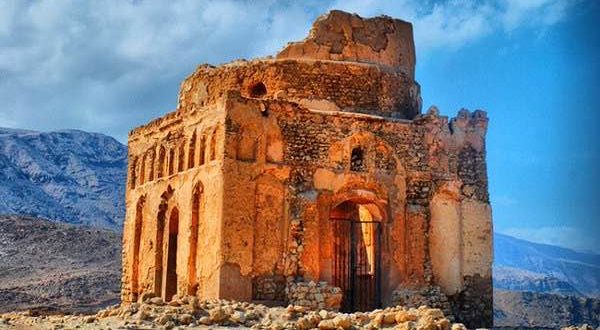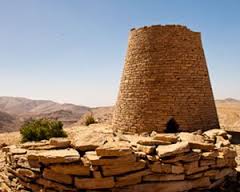Qalhat…the haven of kings
Athir – History of Oman – Prepared by: Nasr Al Busaidi
There is no doubt that the historical cities of Oman, whose ruins and monuments are still the greatest evidence of their greatness and status throughout the ancient centuries, have written epics of glory and status that surpassed all their counterparts from those cities and civilizations that are neighboring them.
There lies that dreamy coastal city located in the southeastern part of Oman on an area of 35 hectares, protected from the east and west by mountains and the sea, and to the north are the ruins of Khor Qalhat, which was a vital port in previous centuries, and to the south are the remains of a huge defensive wall extending from the beach and surrounding the old city to the top of the mountain where the ruins of an isolated building of that Turkish princess (Bibi Maryam) lie, and the remains of scattered ruins aged with Thai and Persian turquoise tell us the history of the maritime and commercial activity practiced by this city, which became a haven for kings of various races from the Turks, Persians and Mongols.
Ships would drop anchor at the port of Qalhat coming from Hormuz, Aden and India to unload their precious cargo of various goods brought from Cathay, China and Africa, and return from this Omani city laden with purebred Arabian horses, whose bloodlines were born in the plains of Quriyat, and which were much preferred by the kings of South India, the sultans of Delhi and the rulers of Persia, as their royal stables were filled with them throughout ancient times and even the Middle Ages. Qalhat, with its ancient monuments throughout the ages, has been classified by scholars as the oldest Omani city ever, although the Omani sources written about Qalhat were very few. The reason is due to the Omani historians who only recorded events in the late eighteenth, nineteenth and twentieth centuries, that is, hundreds of years after Qalhat was a city of kings due to its location, commercial importance and status in those eras with all the meaning of the word. In addition, all Omani historians aimed to record the biographies of the ruling dynasties and the imams who ruled in their various periods. For example, the captains and merchants in Qalhat were not among their interests, and this is the case with most historians at the level of the countries of the world, as the common people, merchants, craftsmen and soldiers were not among their circle of interest. As for the ancient Arab historians who did not recognize, for example, the Omani resistance and the victories it achieved against the invaders and its independence in most periods of its history with its great cities and its role in history, the reason for this, as the British politician Miles (1872-1886 AD) mentioned, was the difference in doctrine that distinguished Oman from the rest, which is the only logic that answers many questions about their neglect of the history of Oman and its ancient civilization.
There is no doubt that most of the studies that now talk about Qalhat have relied heavily on some scattered evidence from Arab writers and travelers and Persian historians who traveled the region during the Middle Ages, in addition to the evidence and antiquities that paint us a harmonious picture of Qalhat and the political, cultural, and economic situation in it during several centuries and even before Christ.
Qalhat’s strategic location and nature, which fortified the city with what humans have made in an amazing way, have made it a commercial and political heavyweight in the region and the neighboring civilizations. The European traveler (Marco Polo) was amazed when he passed through China in 1292 AD, by the solidity of Qalhat’s location in terms of location and fortifications. He said: “The city’s port is very large and of the highest quality, and many ships loaded with goods visit it, and it is used to export purebred Arabian horses to India.”
Qalhat becomes two-way; in the east and northeast it faces the coasts of Makran and southeast Persia across the Arabian Sea, and in the south and southwest it faces Wadi Bani Jaber and Wadi Manqal across the fertile plains, leading through the high mountain paths to the eastern region of the interior of Oman.
Without a doubt, Qalhat’s vital resources have attracted all settlers since ancient times, i.e. since at least the fourth millennium BC, due to all the capabilities that distinguish it from other cities in the region. In addition to the geographical location and wealth of this city, the seasonal winds that allowed them to sail in the Indian Ocean with ease contributed greatly to this settlement and commercial activity that distinguished Qalhat, which was the main port where ships stopped on the coast of the Arabian Sea during their journeys from Hormuz to India and vice versa. Sailing from this city to Makran, for example, was possible throughout the year, which made it an important city with a strategic location since ancient history.
Historical background on Qalhat:
There is no doubt that historical sources, inscriptions and monuments dating back to BC referred to Oman for free, as mentioned in the Assyrian and Babylonian inscriptions, as well as in the modern Assyrian inscriptions that documented the six-month journey undertaken by the king of the land of Kid, called King (Bid), who headed on his journey to Nineveh to pay tribute in 640 BC.
Oman was also known through inscriptions and manuscripts dating back to (Shapur I – 242 BC) as Mazun as part of the Sassanid Empire. All these readings and excerpts indicate that the inhabitants of Oman since ancient times were a mixture of non-Arab populations. Historical evidence through excavations has indicated that Oman was inhabited by a people in the first millennium BC called (Ikhtiophagoi) and a people called (Makai) who were not Arabs but rather Western Semites.
But what is important here is that when (Malik bin Fahm Al-Azdi) migrated to Oman accompanied by 6,000 of his men as a result of the deterioration of economic and political conditions in the ancient kingdoms in the south of the Arabian Peninsula after the caravan routes were cut off by the Persians who defeated Babylon in 539 BC or because of the collapse of the Ma’rib Dam as most traditional accounts say, he found that the Persians had taken control of large parts of Oman under the leadership of (Dara bin Dara bin Bahman). So Malik settled in the city of Qalhat and left his army and their families in this city, then he headed to fight the Persians in the Salut plain near Nizwa in a fierce battle in which Malik bin Fahm defeated the Persians, killed their leader and expelled them from Oman. After that, Malik bin Fahm became the ruler of Oman and made Qalhat his capital, so that this city became the coastal capital of the Malik bin Fahm clan of the Azd tribe for several centuries. We should not forget that when (Sulaima bin Malik bin Fahm) killed his father by mistake, he fled from Qalhat to Kerman, a region located in the southeast of Persia, and became its ruler after he and his grandchildren were able to intermarry with the local people of Persia, and thus formed influence and commercial power between Kerman, Qalhat and India. Therefore, all the kings who ruled Kerman during that period and after were keen to make Qalhat the main center of their merchant activity. Therefore, when the Turkish Seljuks occupied Kerman and expelled the Buhiyids, they marched to Qalhat and took control of it in 1063 AD under the leadership of the Seljuk ruler (Kaward). This continued until 1167 AD, so Qalhat became a landmark for the beginning of political relations between it and the ruling dynasties in Kerman and ancient Hormuz, whose ruling dynasty was founded by (Muhammad Dirham Ku), who came from Saba heading to Qalhat to settle there for a period of time and leave his son and some of his family members there so that Ku could continue his journey towards the other side of the Persian Gulf before settling in ancient Hormuz, which is different from Hormuz Oman. Ancient Hormuz means the city located in Kerman, and it became the main port and market there by the tenth century AD. As the ruling dynasties in Hormuz and Kerman were engaged in endless political conflicts, Qalhat, the Arab capital of Hormuz, was the safe haven for the fleets and kings of Hormuz and their families from the ruling families who greatly pampered themselves in Qalhat, which was distinguished by its beautiful buildings, markets, mosques, and the presence of many craftsmen, merchants, sailors, and bureaucratic nobles of different nationalities as a result of its stability and commercial maritime activity. In 1225 AD, (Mahmoud Al-Qalhati) – named after Qalhat – became the ruler of Hormuz, as he occupied with his strength the coast of the Gulf of Oman, Bahrain, and Qatif, and made Qalhat his refuge. After the death of Mahmoud Al-Qalhati in 1278 AD, his sons fought over power, and they reached the point of fighting and following a policy of assassinations between members of the same family, as did the tyrant (Masoud), son of Mahmoud Al-Qalhati, who slaughtered his brother (Nasrat) to reach power, and thus cases of rebellion and disobedience erupted in Qalhat under the leadership of the Turk (Baha Al-Din Ayaz), who worked with Mahmoud Al-Qalhati and his son, the murdered Nasrat. Therefore, Ayaz prepared an army to fight Masoud, leaving Qalhat at the disposal of his Turkish wife (Bibi Maryam). The two armies met with Hormuz, and Masoud fled the battle, escaping, so that Hormuz became a land of conflict between Ayaz and Masoud and his large army of Mongols, but victory was always in favor. The scale of that Turk who made Qalhat the main headquarters for him and his family and wealth until he died there and the throne of his rule in Qalhat was inherited by the Turkish princess Bibi Maryam who continued to rule this city for forty years during which Qalhat flourished greatly, and during her reign Qalhat remained a refuge for the ruling families who were fighting in Kerman and Hormuz, until Princess Bibi Maryam died and was buried there in that shrine which still stands and bears her name to this day.
So Qalhat was not an ordinary city in history, but rather a refuge for the kings of the Arab tribes of Azd and Hormuz and the first port for travelers who traveled from Yemen to Kerman, as it was an active seaport and a commercial center composed of various nationalities from different countries and a station for seasonal winds throughout the year, as Qalhat was the only Arab capital for the Hormuz families before they finally disappeared from the pages of history.
*Reference: Omani Studies Journal, Issue 15, Ministry of Heritage and Culture – Sultanate of Oman – 2008







